Playfield cleaning
Posted: 11 November 2011 Filed under: Devil Riders, Playfield | Tags: cleaning, pinball, playfield, popbumper, zaccaria 2 Comments »
While dismantling the playfield I noticed that the top flipper bats didn’t have their caps anymore and that the left bottom flipperbat had the cap glued on. I had to break it to get it off. Replacement bats have been ordered.
Also, the metal ramp at the end of the shooter lane is broken. It has a dent there where the ball hits it every time and the front screw holes are broken. I’m still looking for a replacement, let’s hope I find one.
So now I’m done removing everything from the playfield and boy, is it dirty!
The above picture still shows three of the four popbumbers installed, but they have been removed in the mean time and what I found is that one of them had the wrong coil in it and it was missing two screws that actually fixes it to the popbumber bracket…
So now the popbumbers have been removed and I was surprised that the mylar sheets under them aren’t just dirty, but some of them are even torn to pieces…
So now I started cleaning and the difference is amazing! Look at the yellow banner in the picture below, the right side has been cleaned, the left side hasn’t.
Now for the rest of the playfield, metal parts and plastics. Then I can start fixing the sunken inserts. That will be fun…
Pinball Champ ’82 as good as done!
Posted: 6 November 2011 Filed under: General, Pinball Champ '82 | Tags: pinball, zaccaria Leave a comment »
It’s finished! The Pinball Champ ’82 has been put together again using the CPU board from the Devil Riders, using David’s freeplay images (see Zaccaria-Pinball in my links) and me and my dad played a few games. It was great!
Ofcourse during the games we played I noticed a few more things I need to fix, but nothing major. A light needs to be checked/replaced, the doorframe needs to be repainted and the backglass is missing a black siderail and could do with a new lift rail. Also, the player 2 display has one digit that acts up from time to time. I’ll have a look at that too.
Unfortunately there’s a whole in the paint on the backglass just above a lamp. It’s quite an eye-sore. I’ll have to see if there’s a way to fix this…
The machine plays perfectly and I’m really happy with the result. Here’s a little movie with the machine in attract mode. Enjoy…
Driver boards tested and fixed
Posted: 1 November 2011 Filed under: Devil Riders, Electronics, Pinball Champ '82 | Tags: cpu, driver board, electronics, pinball, test program, tools, zaccaria Leave a comment »
So I put together the little address selector tool that Leon designed on his website (see my links) and used it to test both the Pinball Champ ’82 and Devil Riders driver boards.
I used a LED to test each input individually for the eight possible addresses.
I had to do it on the PC82 since I don’t have an independant 5V power supply anymore… really need to fix that!
The Devil Riders driver board was in perfect condition. This machine is turning out to be just a case of bad switches and dirt, lots of dirt… excellent!
The Pinball Champ driver board was another story. I had intermittend faults on connector CN21 while signal that came for the same SCR’s on CN18 where perfect. After a more thorough visual inspection of the board I noticed this:
As the solder didn’t appear broken and I had a very hard time desoldering this connector, I suspect it had been put together this way 29 years ago… So now it’s reseated properly and I replaced four SCR’s that were faulty, this board is now in tip-top shape as well.
I’ve also tested the Devil Riders CPU board with Leon’s test EPROM and it’s also in perfect condition. I’ve also found some discrepancies in the way the Pinball Champ CPU board functions compared to the Devil Riders board. I’ll get into that next as it’s the only thing that needs to be done before I can really get into the Devil Riders.
Wish me luck!
So the electronics seem OK…
Posted: 27 October 2011 Filed under: Devil Riders, Electronics | Tags: electronics, pinball, zaccaria Leave a comment »
Well, I’ve got the fuse back into the power supply and sorted out the previous repairs. I tried testing the CPU but apparantly the 27C64 doesn’t work as well as a 2764. Don’t know why, it should work. So I just popped in the original game EPROMS, connected the power supply and the displays and that worked.
So I connected everything else and here is the result:
I’ve ran the normal diagnostics and except for some lights and switches here and there, everything seems to work. The little motorcycle in the head moves a little bit, but since there still are some wires hanging there connected to nothing, that doesn’t surprise me.
The biggest job is going to be cleaning up… this machine is VERY dirty.
OMG it still works!
Posted: 26 October 2011 Filed under: Devil Riders, General | Tags: neon tube, pinball, zaccaria Leave a comment »
While putting the new parts I got in the mail today in my work room, I checked the GI on the Devil Riders and…
OMG THE NEON STILL WORKS! After 27 years! Amazing…
Me so happy!
Pinball number 2
Posted: 20 October 2011 Filed under: Devil Riders, General | Tags: condition, pinball, zaccaria Leave a comment »
Well, now I’ve done it! I’ve gone and bought another machine. This time it’s a Devil Riders, also from Zaccaria, and also a 2nd generation. Mechanically it looks in better shape than the Pinball Champ, but the electronics have been “repaired” by an amateur (according to the seller). But for 100€ I’m not too bothered about it. The machine looks complete, except for 2 leg bolts.
Here are some pictures I took.
I’m going to test the CPU board of this machine in the other machine and make it work. That way I can compare the two boards and see where the problem is with my Pinball Champ CPU board. I’ll also start taking the Devil Riders apart and make a list of things I need to order so I can minimise shipping cost.
As always, I’ll keep you posted!
Humpty Dumpty back together again
Posted: 18 October 2011 Filed under: Cabinet, Pinball Champ '82, Playfield | Tags: cabinet, legs, neck, pinball, zaccaria Leave a comment »
It’s starting to look like a pinball machine agian!
I’ve put the playfield back together and noticed that the left top flipper didn’t work and the right top flipper was weak. A quick pass with some sanding paper between the leaf contacts and they’re both tiptop again.
Here are some detail shots. Remember, I’m making this pinball playable, not perfect.
Then I turned my attention to the neck. In my previous post I mentioned I was going to use a toothbrush to get the white spots in the black paint, but when I was at the store to get some more ground paint for the legs, I saw a black paint spray can that already had the white spots in it. It’s called “Granit” effect. So I bought a can and here is the result. I used one coat of black and one coat of the “Granit” black.
I like it!
Next where the legs. I got the two back legs back from the blacksmith and they were perfect (at a cost of an amazing 5€!). So I sanded them down, gave them a base coat, two coats of glossy black and new levelers (with rubber protectors).
I also had a look at all the ground wires. NONE of them were connected in the transformer casing. That’s fixed now, my hair no longer reaches for the sky when I press the flipper buttons 😀
So I’m almost there, but not quite. The CPU board still needs work and the driver board still needs a thorough overhaul. In the mean time here’s a picture of where I am now.
Beheaded and dismembered
Posted: 13 October 2011 Filed under: Cabinet, Pinball Champ '82 | Tags: cabinet, cleaning, neck, painting, pinball, rust, zaccaria Leave a comment »
No, I didn’t kill the pinball machine! I just started some work on the neck and legs.
So the legs have been taken off. The front legs are in good shape. The rusted levelers came out with some WD-40 and except for some rust the legs are fine. Sanding and painting up next. The back legs however are problematic. The rusted levelers are rusted in place and one leg is even bent at the bottom. I considered buying four new legs and levelers, but then I heard that there’s a blacksmith in our village. I should get those two back legs back tomorrow, straightened and levelerless (is that a word?). I’ve also ordered four new levelers.
I’ve also cleaned the head door. The ZM1550 display modules arrived today and these will be soldered in place after the weekend. So the door is ready to take the repaired displays. The guy who sold the modules to me added an extra display controller board which I will modify to take a LED display so it can run on 5V only and I can use it to test the CPU board without the 160V. I found this modification on Leon’s website (see my links for the flipper-pinball-fan site).
I’ve also ordered a new lock for the head and bought four M10 bolts and washers as the originals are missing. Unfortunately the bolts don’t seem to fit, I guess those Zaccarians used non-metric size bolts, I’ll have to check that.
Between the head and the cabinet, there is a neck with a little metal grill. This grill is completely rusted, so I beheaded the pinball machine and took the neck off.
I immediately noticed a couple of things; first, one side of the neck was never painted and second the metal strip holding the cabinet glass was badly rusted.
So I’ve removed everything from the neck and sanded it down for a new paintjob. I’m going to follow David Gersic’s advice (see his zaccaria-pinball site in my links section) on getting the white splatter back on the black paint using a tooth brush.
I’ve also cleaned up the metal strip using some steel wool and chrome polish. Nothing more, I want to play this machine, not put it in a museum.
The metal grill has had it’s ground coat too.
The black paint you see under there is a remnant from painting the same style grill that resides at the bottom back side of the cabinet (nicely hidden). It came out perfect, so that’s why I’m doing this one in the same manner.
I’ve tried to paint the transformer casing with Hammerite paint, but that was a big mistake. Now it needs to harden for 2 weeks until I can sand it off again and start over.
Progress report
Posted: 1 October 2011 Filed under: Cabinet, Electronics, Pinball Champ '82, Playfield | Tags: cleaning, cpu, display, electronics, memory, pinball, playfield, test program, zaccaria, ZM1550 Leave a comment »
Well, the playfield is almost done!
I’ve cleaned out the cabinet and head.
I’ve installed the new microswitch (#52) that let’s the machine know the ball is on the 2nd level playfield.
I’m still missing a few rubbers, but they are in the mail.
The 20A fuse on the transformer box burned out while I was working on the playfield. I stuck a new one in and that burned out too. So I removed all the lights and measured the wiring to look for shorts. There were none. I stuck the lamps back in one by one and now everything works… Weird.
The guy I bought the ZM1550 display modules from mailed me to say he is abroad for work and will send them next week.
I still have the CPU board problem though… I’m going to swap out IC’s 8, 19, 31 and 37 for good measure. The way the CPU reacts to the DIP switch 4 position looks like it’s unable to read the settings once PROGR is off. When I put the switch back in PROGR mode, I can read all the settings, which to me means the RAM is good.
I’m also writing a extensive memory test program that will write alternative 0x55 and 0xAA’s to every memory position between 0x1800 and 0x1BFF. When a test fails it will show which test failed in which nibble at which location on the Player 1 display. This way I should be sure if the memory is good and I can test with both positions of DIP switch 4.
I’ll keep you updated.
Still debugging CPU problems…
Posted: 25 September 2011 Filed under: Electronics, Pinball Champ '82 | Tags: cpu, electronics, memory, pinball, test program, zaccaria Leave a comment »
As I stated in an earlier post, the pinball machine will only work when it is in PROGR mode (DIP switch 4 to ON position on the CPU board).
When the machine is in normal mode (DIP switch 4 to OFF position), al the displays show 0’s and that’s it. Sometimes not all displays will light up at once and it will take up to 30 seconds for all of them to turn on.
Lights on the head and playfield will stay on or off at random (changes every time I restart the machine).
When actuating the Test-Advance button in the door, it will go to test #1 and all the displays will test correctly showing 0’s, 1’s, 2’s, etc… up to 9’s and back to 0’s, but after that, there’s nothing I can do to stop that test, go to the next test or whatever.
Also, when I start the machine on normal mode, the error LED on the soundboard lights. Actually it always lights and never turns off. I noticed it takes a little time to turn off when the machine is turned on in PROGR mode, so I guess it’s the CPU not initialising the sound card.
I’ve tested the IC’s 31, 37, 19 and 8, but they all do what they’re supposed to do…
What you can see here is that the PROGR signal enables addresses 1C00 to 1C7F (or 1800 to 187F, since AB10 is not used but the software holds it high for RAM access) for writing when it is LOW. When the switch is put back to the OFF position, this memory range becomes read only.
So what’s next? I’m not really sure. There’s a few options:
- Maybe the TMS40L45-45NP is not a good substitute for the 2114L. I found some people who still have these, so I’ll get me one and see what happens.
- I write a test program than constantly writes to RAM when the CPU board LED is on and constantly reads from RAM when the CPU board LED is off and follow the R/W signal with my logic probe.
- Call Mulder and Scully to find the ghost in my machine…
Anyway, as always I’ll keep you updated.

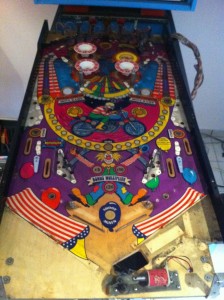
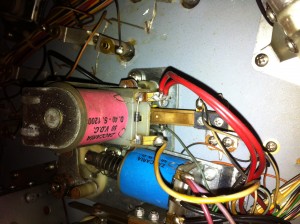
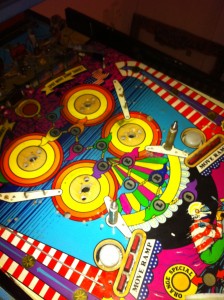

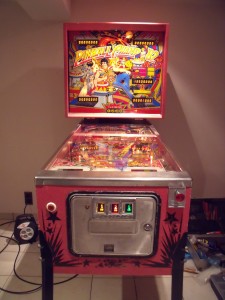


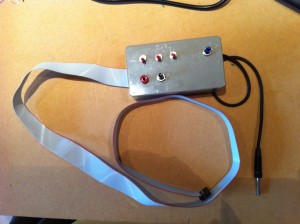
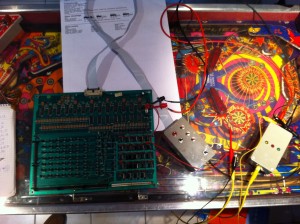
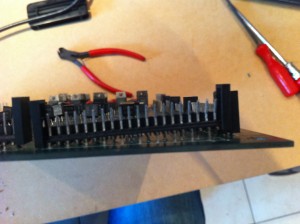






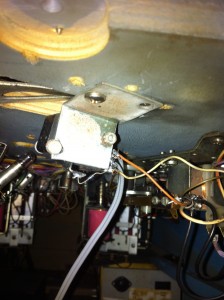
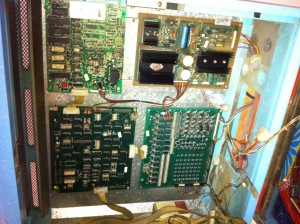




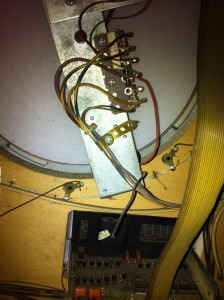



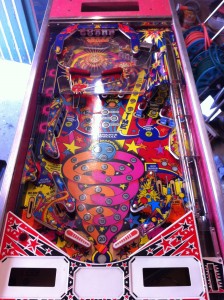
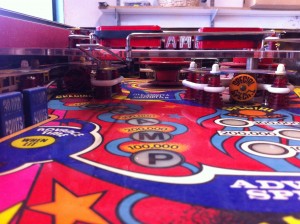





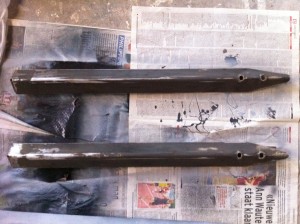

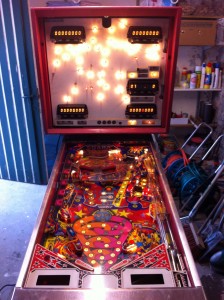



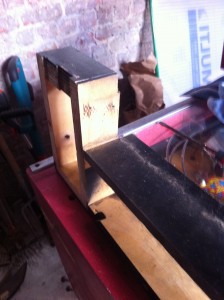

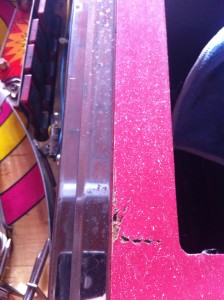


 Flippers.be
Flippers.be Videolan.org – The home of VLC
Videolan.org – The home of VLC